Луи пастер доклад на английском
Обновлено: 04.07.2024
of germ theory to the prevention of disease that he became known as 'The Father of Microbiology'. Pasteur did not create germ theory, but he proved it to be correct. Once he had achieved this, he set about finding ways to prevent germs, the microorganisms present in the air, from infecting food and people. 2. He completed his famous experiment proving that microorganisms were present in the air while working for a wine company. He was trying to discover why wine sometimes went bad as it was being made. Once he had found the cause – microorganisms – he began to develop the process which carries his name – pasteurisation. It was perfectly possible to kill all the microorganisms in food by boiling it, a process known as sterilisation, but this damaged the taste and the quality of the food. Pasteur's process killed not all, but most of the microorganisms and it did not harm the quality of food. Much of the food we eat today is pasteurized. (L 3. His next achievement was built on the discovery of the British scientist Edward Jenner. Many years earlier, Jenner had discovered a way of giving people resistance to the deadly disease smallpox, by injecting them with a similar disease that was found among cows. The process became known as vaccination. Pasteur applied germ theory to his work and looked at samples of blood taken from healthy and infected animals. He grew bacteria in his laboratory and used them to infect animals. By chance, some of these germs failed to grow well in his laboratory; these weak germs were then used to infect some chickens. Although the chickens suffered at first, they made a complete recovery and could not be infected again. In this way, he discovered a way of increasing resistance to disease. L. Pasteur developed vaccines for many serious diseases including cholera and anthrax. At that time, these illnesses were certain death for anyone who caught them. 4. L. Pasteur's discoveries revolutionised work on infectious diseases. Pasteur's vaccines were different from Jenner's in one important way. Jenner found a weak form of smallpox and transferred it to humans. Pasteur weakened the disease in a laboratory and immunised people with that weakened form. Thanks to the work of Pasteur, we now live longer, our food stays fresh longer and we are less likely to die of disease. Indeed, smallpox is no longer found anywhere in the world, due to a huge vaccination programme carried out in the 20th century. This could never have happened without the scientific achievements of The Father of Microbiology. [based on: Macmillan Guide to science. SB, 2012
Louis Pasteur was born in 1822. He was a prominent French chemist, one of the
founders of modern microbiology. His research work helped much to establish the
field of bacteriology. In his early Pasteur devoted his energies to the discovery of
microorganisms in wine and beer production. He introduced the idea of heat
sterilization (pasteurization) for these products and milk.
Later he became interested in hydrophobia. He showed that viral pathogenic
properties could be attenuated by passing the virus through the body of a proper
animal. On the basis of these observations he developed a vaccine for hydrophobia.
Continuing his investigation L. Pasteur discovered the method to prevent some
infections diseases by introducing attenuated causative agents. This method is
known as vaccination. It has helped to fight against many infections diseases.
Луи Пастер родился в 1822 году. Он был известный французский химик, один изоснователи современной микробиологии. Его исследовательская работа помогла многое установитьполе бактериологии. В его начале Пастер посвятил свою энергию на открытиемикроорганизмы в производстве вина и пива. Он представил идею теплаСтерилизация (пастеризации) для этих продуктов и молока.Позже он стал заинтересован в Водобоязнь. Он показал, что вирусные болезнетворныесвойства могут быть смягчены путем передачи вируса через тело надлежащегоживотное. На основе этих наблюдений он разработал вакцины для Водобоязнь. Продолжая свое расследование л. Пастера обнаружил метод, чтобы предотвратить некоторыеинфекционные болезни путем введения ослабленного возбудителей. Этот метод являетсяизвестный как вакцинация. Она помогает в борьбе против многих заболеваний, инфекций.
Луи Пастер родился в 1822 г. Он был видный французский химик, один из
основателей современной микробиологии. Его исследовательская работа помогла много установить
области бактериологии. В начале своей Пастера посвятил свою энергию к открытию
микроорганизмов в вина и пива производства. Он ввел понятие тепловой
стерилизации (пастеризации) для этих продуктов и молока.
Позже он заинтересовался бешенством. Он показал , что вирусные патогенные
свойства могут быть ослаблены путем передачи вируса через тело надлежащего
животного. На основе этих наблюдений он разработал вакцину против бешенства.
Продолжая его исследование Л. Пастер открыл метод , чтобы предотвратить некоторые
инфекционных заболеваний путем введения ослабленных возбудителей. Этот метод
известен как прививки. Это помогло бороться против многих инфекционных заболеваний.
луи пастер родился в 1822 году.он был выдающимся французским химиком, один изоснователей современной микробиологии.его исследовательская работа позволила значительно установитьобласти бактериологии.в его начале пастер посвятил свою энергию на открытиемикроорганизмы в вино и пиво, производства.он представил идею тепластерилизация (пастеризации) для этих продуктов и молоко.позже он заинтересовался hydrophobia.он показал, что вирусные патогенныхсвойства можно смягчить путем передачи вируса через тело надлежащегоживотное.на основе этих замечаний он разработал вакцину для hydrophobia.его расследование продолжается. пастор обнаружили метод для того, чтобы предотвратить некоторыеинфекционными заболеваниями путем введения ослабленных возбудителей.этот методизвестно, что вакцинация.она помогает бороться со многими инфекционными заболеваниями.
Слайды и текст этой презентации
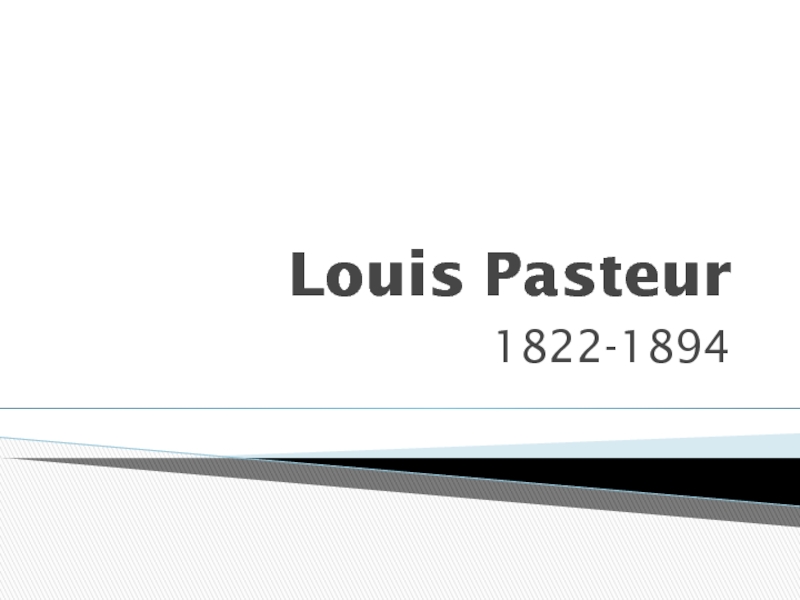
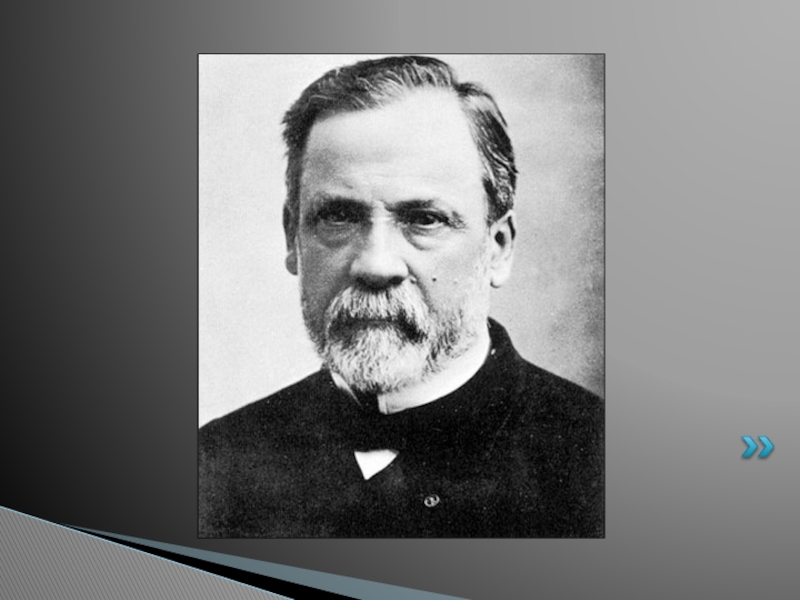
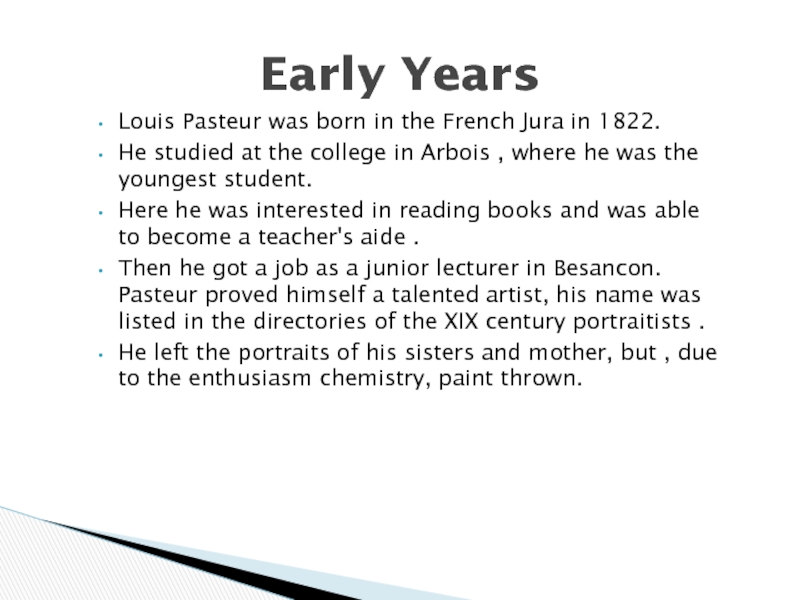
Louis Pasteur was born in the French Jura in 1822.
He studied at the college in Arbois , where he was the youngest student.
Here he was interested in reading books and was able to become a teacher's aide .
Then he got a job as a junior lecturer in Besancon. Pasteur proved himself a talented artist, his name was listed in the directories of the XIX century portraitists .
He left the portraits of his sisters and mother, but , due to the enthusiasm chemistry, paint thrown.
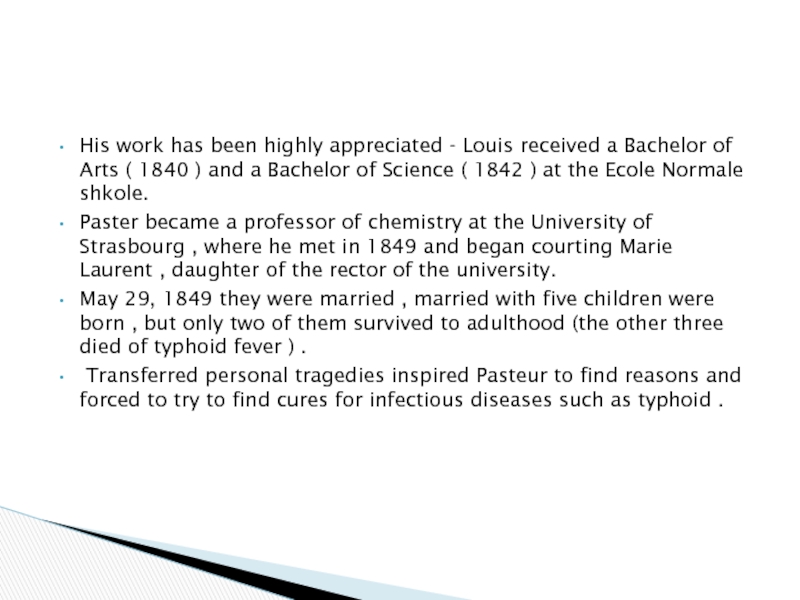
His work has been highly appreciated - Louis received a Bachelor of Arts ( 1840 ) and a Bachelor of Science ( 1842 ) at the Ecole Normale shkole.
Paster became a professor of chemistry at the University of Strasbourg , where he met in 1849 and began courting Marie Laurent , daughter of the rector of the university.
May 29, 1849 they were married , married with five children were born , but only two of them survived to adulthood (the other three died of typhoid fever ) .
Transferred personal tragedies inspired Pasteur to find reasons and forced to try to find cures for infectious diseases such as typhoid .
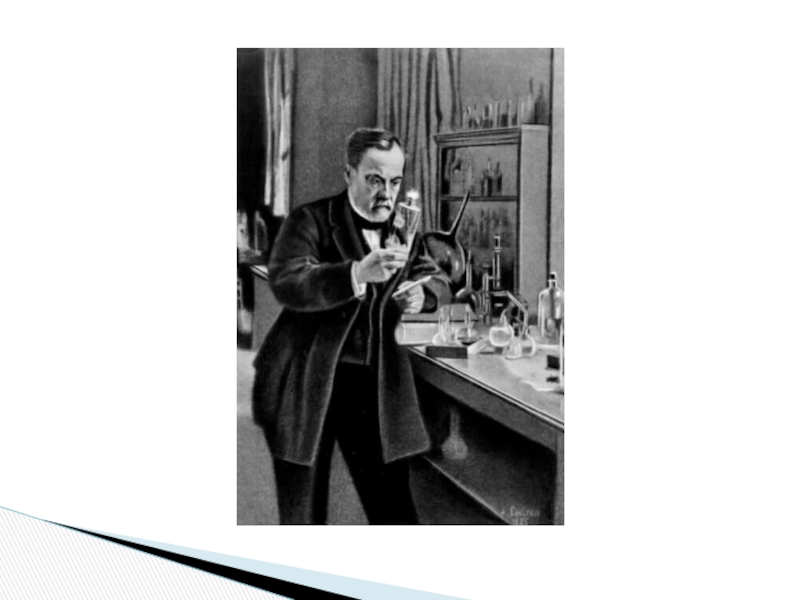
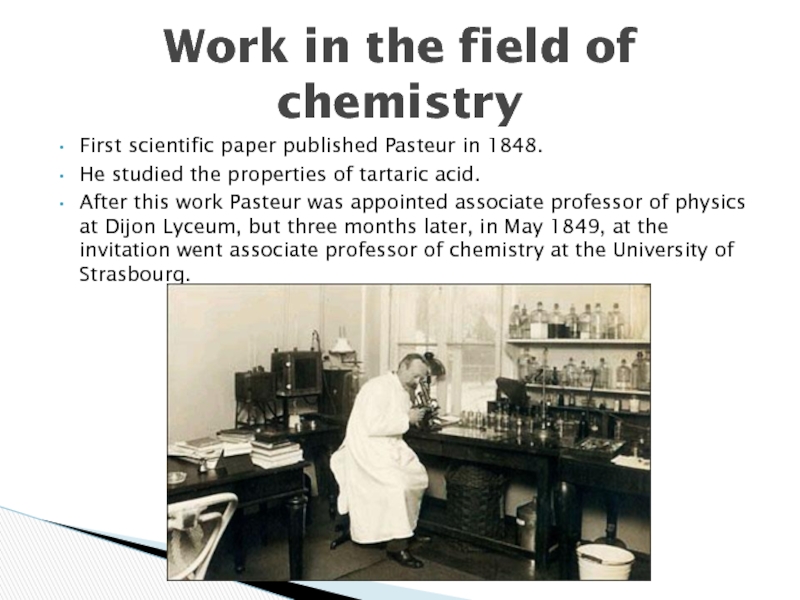
First scientific paper published Pasteur in 1848.
He studied the properties of tartaric acid.
After this work Pasteur was appointed associate professor of physics at Dijon Lyceum, but three months later, in May 1849, at the invitation went associate professor of chemistry at the University of Strasbourg.
Work in the field of chemistry
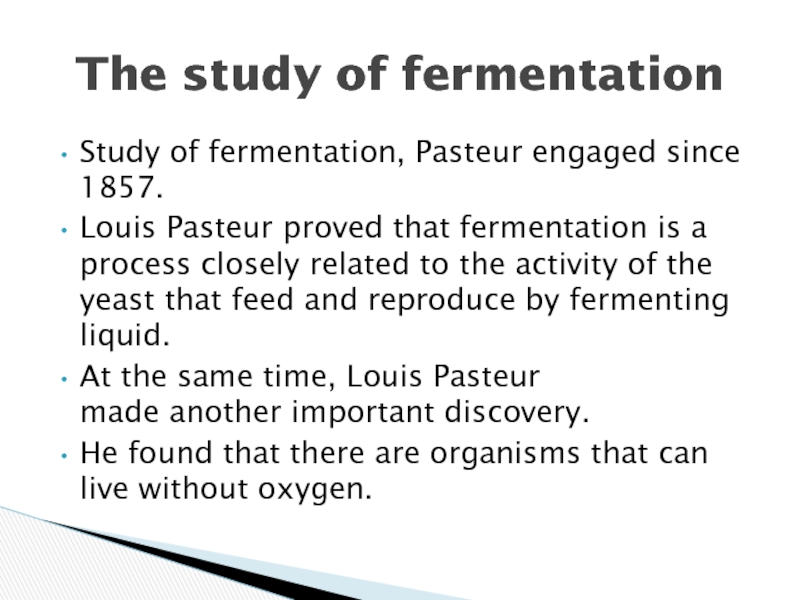
Study of fermentation, Pasteur engaged since 1857.
Louis Pasteur proved that fermentation is a process closely related to the activity of the yeast that feed and reproduce by fermenting liquid.
At the same time, Louis Pasteur made another important discovery.
He found that there are organisms that can live without oxygen.
The study of fermentation
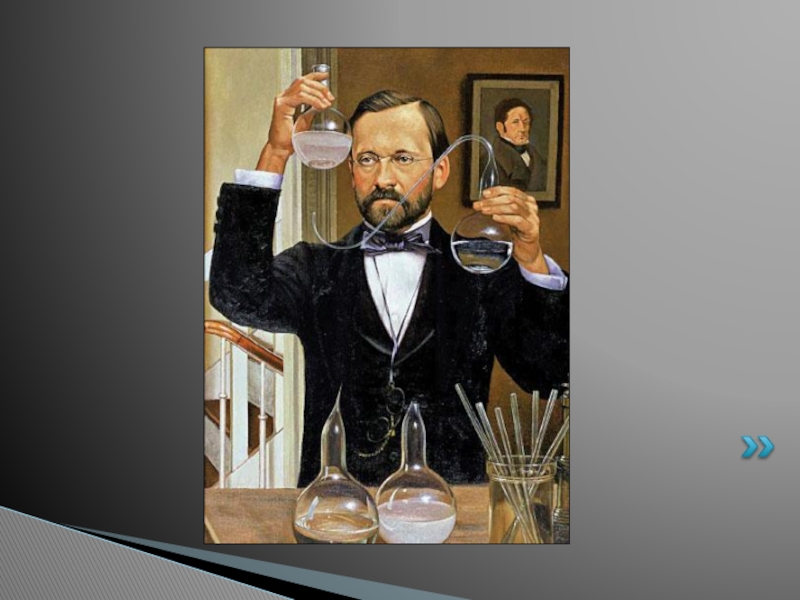
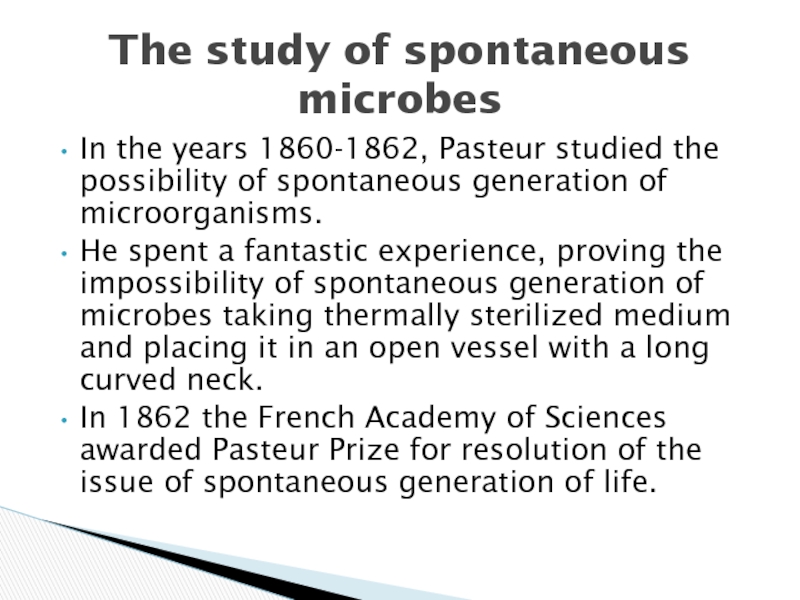
In the years 1860-1862, Pasteur studied the possibility of spontaneous generation of microorganisms.
He spent a fantastic experience, proving the impossibility of spontaneous generation of microbes taking thermally sterilized medium and placing it in an open vessel with a long curved neck.
In 1862 the French Academy of Sciences awarded Pasteur Prize for resolution of the issue of spontaneous generation of life.
The study of spontaneous microbes
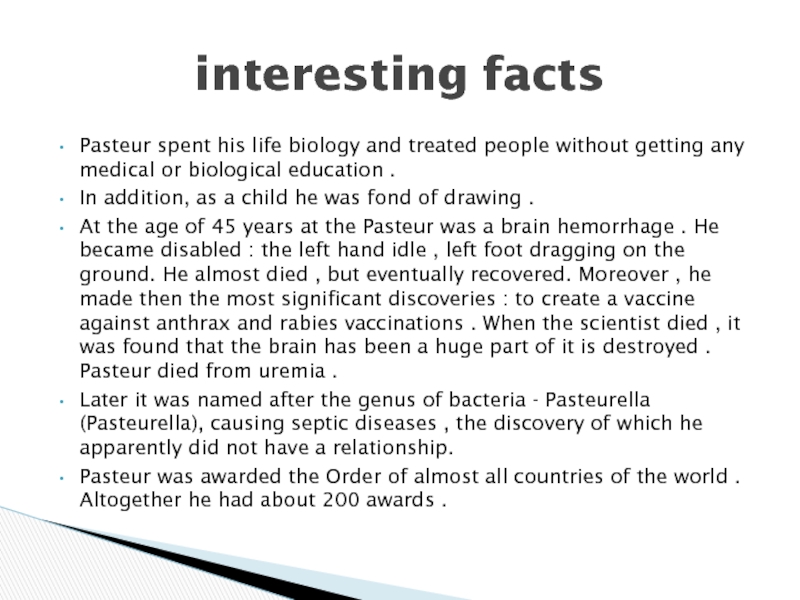
Pasteur spent his life biology and treated people without getting any medical or biological education .
In addition, as a child he was fond of drawing .
At the age of 45 years at the Pasteur was a brain hemorrhage . He became disabled : the left hand idle , left foot dragging on the ground. He almost died , but eventually recovered. Moreover , he made then the most significant discoveries : to create a vaccine against anthrax and rabies vaccinations . When the scientist died , it was found that the brain has been a huge part of it is destroyed . Pasteur died from uremia .
Later it was named after the genus of bacteria - Pasteurella (Pasteurella), causing septic diseases , the discovery of which he apparently did not have a relationship.
Pasteur was awarded the Order of almost all countries of the world . Altogether he had about 200 awards .

№ слайда 1
Louis Pasteur 1822-1894

№ слайда 2

№ слайда 3
Early Years Louis Pasteur was born in the French Jura in 1822. He studied at the college in Arbois , where he was the youngest student. Here he was interested in reading books and was able to become a teacher's aide . Then he got a job as a junior lecturer in Besancon. Pasteur proved himself a talented artist, his name was listed in the directories of the XIX century portraitists . He left the portraits of his sisters and mother, but , due to the enthusiasm chemistry, paint thrown.

№ слайда 4
His work has been highly appreciated - Louis received a Bachelor of Arts ( 1840 ) and a Bachelor of Science ( 1842 ) at the Ecole Normale shkole. His work has been highly appreciated - Louis received a Bachelor of Arts ( 1840 ) and a Bachelor of Science ( 1842 ) at the Ecole Normale shkole. Paster became a professor of chemistry at the University of Strasbourg , where he met in 1849 and began courting Marie Laurent , daughter of the rector of the university. May 29, 1849 they were married , married with five children were born , but only two of them survived to adulthood (the other three died of typhoid fever ) . Transferred personal tragedies inspired Pasteur to find reasons and forced to try to find cures for infectious diseases such as typhoid .

№ слайда 5

№ слайда 6
Work in the field of chemistry First scientific paper published Pasteur in 1848. He studied the properties of tartaric acid. After this work Pasteur was appointed associate professor of physics at Dijon Lyceum, but three months later, in May 1849, at the invitation went associate professor of chemistry at the University of Strasbourg.

№ слайда 7
The study of fermentation Study of fermentation, Pasteur engaged since 1857. Louis Pasteur proved that fermentation is a process closely related to the activity of the yeast that feed and reproduce by fermenting liquid. At the same time, Louis Pasteur made another important discovery. He found that there are organisms that can live without oxygen.

№ слайда 8

№ слайда 9
The study of spontaneous microbes In the years 1860-1862, Pasteur studied the possibility of spontaneous generation of microorganisms. He spent a fantastic experience, proving the impossibility of spontaneous generation of microbes taking thermally sterilized medium and placing it in an open vessel with a long curved neck. In 1862 the French Academy of Sciences awarded Pasteur Prize for resolution of the issue of spontaneous generation of life.

№ слайда 10
interesting facts Pasteur spent his life biology and treated people without getting any medical or biological education . In addition, as a child he was fond of drawing . At the age of 45 years at the Pasteur was a brain hemorrhage . He became disabled : the left hand idle , left foot dragging on the ground. He almost died , but eventually recovered. Moreover , he made then the most significant discoveries : to create a vaccine against anthrax and rabies vaccinations . When the scientist died , it was found that the brain has been a huge part of it is destroyed . Pasteur died from uremia . Later it was named after the genus of bacteria - Pasteurella (Pasteurella), causing septic diseases , the discovery of which he apparently did not have a relationship. Pasteur was awarded the Order of almost all countries of the world . Altogether he had about 200 awards .
ПАСТЕР, ЛУИ (Pasteur, Louis) (1822–1895), французский микробиолог и химик, основоположник современной микробиологии. Родился 27 декабря 1822 в Доле. Окончил Высшую нормальную школу в Париже (1847), здесь же защитил докторскую диссертацию (1848). Преподавал естественные науки в Дижоне (1847–1848), был профессором Страсбургского (1849–1854) и Лилльского (с 1854) университетов. В 1857 стал деканом факультета естественных наук в Высшей нормальной школе, с 1867 – профессор химии Парижского университета. В 1888 основал и возглавил Научно-исследовательский микробиологический институт (впоследствии Пастеровский институт).
Свое первое открытие Пастер сделал еще в студенческие годы: он обнаружил оптическую асимметрию молекул, отделив друг от друга две кристаллические формы винной кислоты и показав, что они различаются своей оптической активностью (право- и левовращающие формы). Эти исследования легли в основу нового научного направления – стереохимии. Позже Пастер установил, что оптическая изомерия характерна для многих органических соединений, при этом природные продукты, в отличие от синтетических, представлены только одной из двух изомерных форм. Он открыл способ разделения оптических изомеров с помощью микроорганизмов, усваивающих один из них.
В 1865 Пастер занялся изучением природы заболевания тутового шелкопряда и в результате многолетних интенсивных исследований установил (1880) заразность болезни и время ее максимального проявления, разработал методы борьбы с нею. Изучая другие заразные болезни животных и человека (сибирской язвы, бешенства, куриной слепоты, краснухи свиней и др.), пришел к окончательному выводу, что все они вызываются специфическими возбудителями. На основе разработанного им представления об искусственном иммунитете предложил метод прививок против этих и других инфекционных заболеваний с использованием ослабленных культур соответствующих микроорганизмов-возбудителей. Предложил назвать ослабленные культуры вакцинами, а процедуру их применения – вакцинацией. В 1880 Пастер начал исследование бешенства и установил вирусную природу этого заболевания. В 1885 им была сделана первая прививка от бешенства человеку.
Пастер был членом Академий наук многих стран, в частности Петербургской Академии наук. Состоял членом Парижской Академии наук, Французской Академии.
Читайте также:

